What to Know Before Moving an Upright Piano
Some very unique piano moving techniques have been developed over the last century that greatly
You need to be aware of the weight of the upright piano you will be moving in order to have enough manpower present when you move it. The very biggest upright piano’s weight can hit 8 – 900 lbs. Small uprights start at 300 – 400 lbs., so even they are quite heavy. Yet no matter what size a piano is, it’s still a very delicate musical instrument and as such, must be carefully handled. Review the section on establishing your crew size in order to learn more about this and to set your crew size.
But always remember the most important of our DIY piano moving tips – even with full knowledge of piano moving techniques, actually moving your piano carries with it a lot of responsibility for the piano movers’ safety, the piano’s condition when you’re done moving it, and its value. So, before proceeding on to our tips about how to move a piano, please be sure to review our sections on piano moving warnings and piano moving
How Much Do Piano Movers Cost
The cost to move an upright piano depends on the move distance and the peculiarities of the pick-up and delivery locations. As a rule of thumb, the greater the distance and the more difficult the job, the higher the cost will be.
Needless to say, moving a piano locally is much cheaper than moving a piano across the country, as the relocation takes much less time and fuel. When calculating the moving cost, professional piano movers charge about $1.50-$2.50 per mile for a local move.
Any obstacles that increase the difficulty of taking a piano in or out of a home increase the piano moving cost as well – moving companies usually charge an extra fee for moving a piano along a staircase ($5–$10 per step or $40-$100 per staircase) and/or through narrow doorways, tight spaces, or other obstacles ( $40–$240per hardship).
To sum it up:
- How much does it cost to move a piano across town – the average cost to move an upright piano locally comes to about $150-$300 for local moves;
- How much does it cost to ship a piano cross country – for long distance moves, the upright piano shipping cost ranges between $500 and $800.
Piano Casters
Pianos should not be rolled around on their metal casters. The casters are just decorative and not very functional because when so used, they can easily gouge a new hardwood floors finish. As you can see below, they’re quite small and when a piano’s constructed, they’re spaced on the four corners of the piano so that all of the piano’s weight is centered between them. On upright pianos, two of the casters are on the front two weak decorative legs.
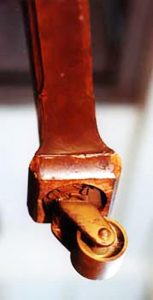
Over time, as the piano sits in one place, the casters tend to deteriorate. So they can jam up on you when you go to push the piano on them. Pushing a grand piano around on its leg casters can even cause a leg to break. Pushing an upright piano on them could break the weak front legs. Some uprights such as the one shown below have 4 decorative legs with casters. Any one of them could be easily broken by pushing the piano on them.

If the casters stick in place, they’ll gouge your hardwood floors or even tear your carpeting. Besides the danger of a stuck caster, they do not virtually eliminate the weight of the piano for piano moving as is done when it is mounted upon our 4 wheel piano dolly. So, all in all,
However, a bunch of you can lift a piano up a bit and move it around a bit keeping its weight from bearing down upon the casters. But
4 Wheel Piano Dolly
Whenever a 4 wheel piano dolly can be used to transport the piano, the muscle power on the part of the crew to move it is reduced to almost nothing. This is because all of the piano’s weight is centrally supported by the dolly. A piano properly balanced on a dolly is effectively almost weightless to move because a light hand pushing it easily overcomes inertia on level surfaces.
An upright piano mounted on its feet on the 4 wheel dolly.

An upright piano mounted on its side on the 4 wheel dolly.
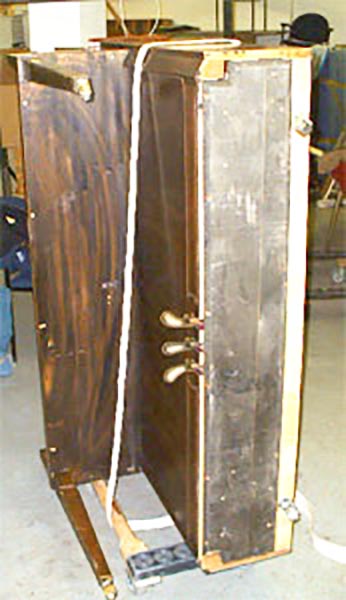
On inclines or ramps, the piano’s weight is expressed on the low end of the incline. Therefore, at least 3 men are needed when moving even a small piano because one man controls the light side and 2 men need to be positioned on the heavy side of the incline to handle the piano’s weight.

Below is a picture of a small upright piano properly mounted on its side on a4 wheel dolly. Notice that no one is holding it. This is only possible because it’s on flat ground and it’s balanced correctly on the dolly, so it just sits there as is, without needing a steadying hand.

Below is a picture of the same piano properly mounted on its feet on the dolly. Again, no one is holding it so it just sits there because it’s centered and therefore balanced on the dolly and it’s on flat ground. Notice that in this centered position, the dolly juts out a bit in front of the piano. This is how the dolly must be placed under the piano in order to balance the weight of its keyboard as well as the weight of its heavy case which contains its cast iron harp.

It is very desirable to do as much of the piano moving as possible
with as little human effort as possible.
So it stands to reason that the dolly is to be used as much as possible. It is simply the easiest way to move a piano around (other than the miles covered when the piano is being transported sitting on a truck). It can be used to move a piano over level ground or on inclines and ramps or for tipping it up or down to get over a curb or 1 step. The piano dolly also can be used to transport the piano on top of plywood or masonite to go over grass, cobblestones, gravel, sand or any other uneven or loose surface. When doing this, though, always use at least 4 or 5 people to push it and to rotate the plywood or masonite from behind to in front of the piano.
So, once the number of people needed on your crew has been determined, the first thing they will have to do with an upright piano is to mount it up onto a dolly. As simple a task as this might appear to be to the uninitiated, it is really somewhat involved because you’re elevating 400 – 800 lbs. almost a foot up onto an unstable rolling platform. So very thorough instruction in dolly mounting techniques will be given in the dolly mounting section.
Tip, Lift, Cheat 1 Step Only
So, starting at the place where the piano is sitting, if no more than 1 step will be encountered at any given point in the

The piano will end up on the dolly on its feet (on its bottom) onto the dolly’s padded rails as shown in the picture below.

The way to move your upright piano over 1 step is by just using a slight tip of the piano on the dolly up/down as it is being pushed along.
To do this, you will use the humpstrap to lift one end of the piano on the dolly welded together as one unit, so to speak, over the step (as is shown in the picture sequence below). In the moving
without having to take the piano off of the dolly and carry it over that step and then put it back onto the dolly.
Just using a tip of the piano on its feet on the dolly in this manner will not work to cheat more than 1 consecutive step with an upright piano because the bottom edge of the piano (on the low side of the tip) will scrape the ground, potentially chipping it. Also, the angle of
Tip, Lift, Lower to Cheat 2 – 4 Steps Only
In order to do bigger cheats (up to as many as 4 consecutive low steps or as many as 3 consecutive higher steps at any given point on your move path), a different technique must be utilized. For 2, 3, or 4 step cheats up/down the stairs, the upright piano is first placed on its side on the dolly. Then, with the bottom of the upright facing the steps, it is positioned on the dolly up to and (if possible) over the 1st step as shown in the picture below.
In this position
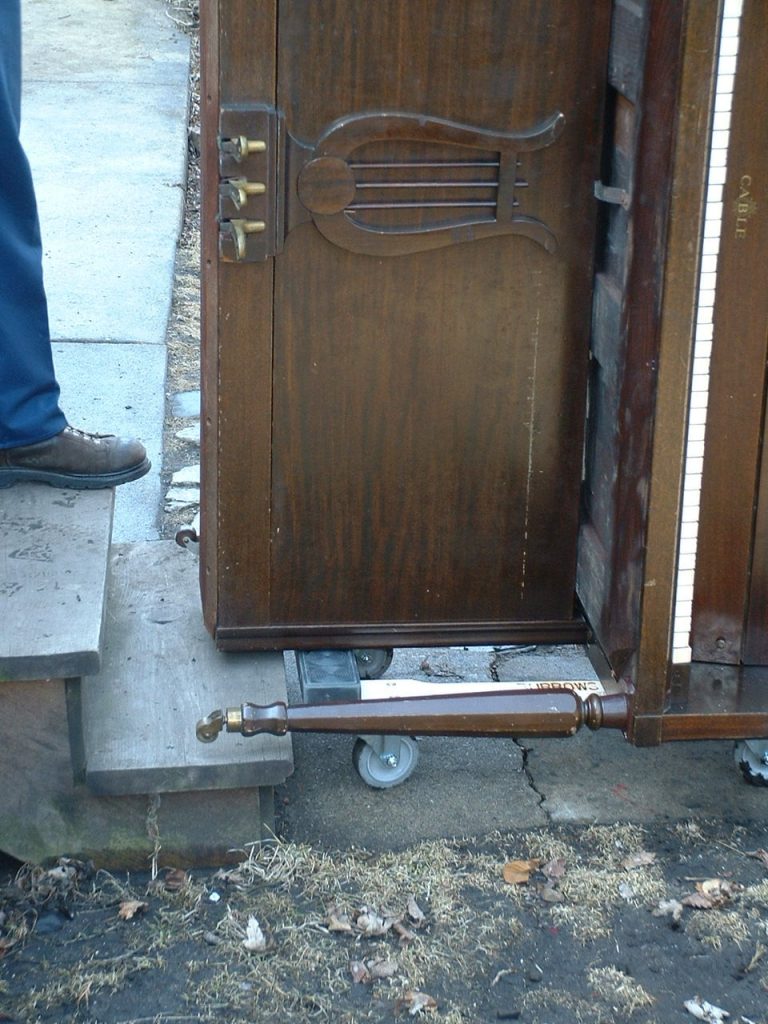
We then finish cheating the other 2 steps by tipping the upright forward
so that its bottom is made to lean against the stairs hanging over the top by a foot or two. Then we just push it up and over and onto the deck
Notice that as the tip begins on this 3 step cheat, we have balanced the upright on the first step, being careful not to let the weak leg touch the stair so as not to break it. Then, we extricated the dolly from under the bottom side of the piano and placed it between the piano and the stairs to protect
Next, we carefully tip the upright piano up and over the top step as shown in the following 3 picture sequence.

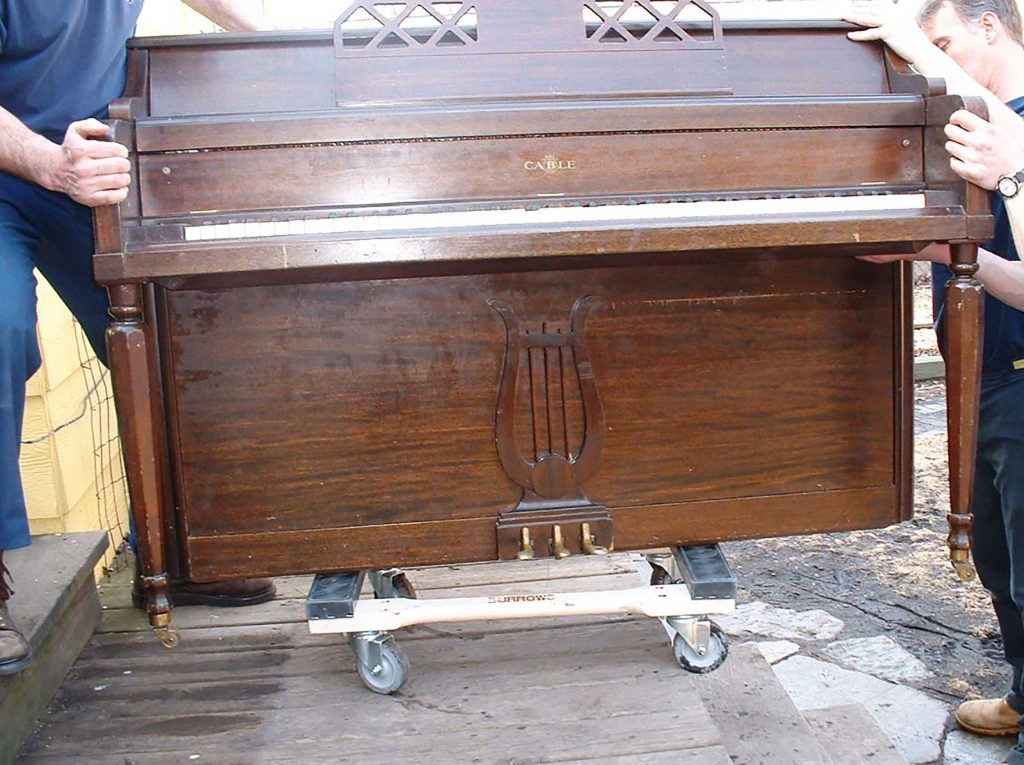
If we were to just have one more step to traverse, we couldn’t push the upright up on the dolly over the edge of the landing as was done here. Instead, we’d not use the dolly as a
This same process is reversed coming down the stairs. The piano comes down the steps with its bottom facing the steps just as it went up . The piano is slid out to the 2 bottom men and they tip it down once it’s out enough.
Then the piano slides down a bit and when it finishes its descent, it can just finish being tipped right up onto the dolly which is waiting on the ground.
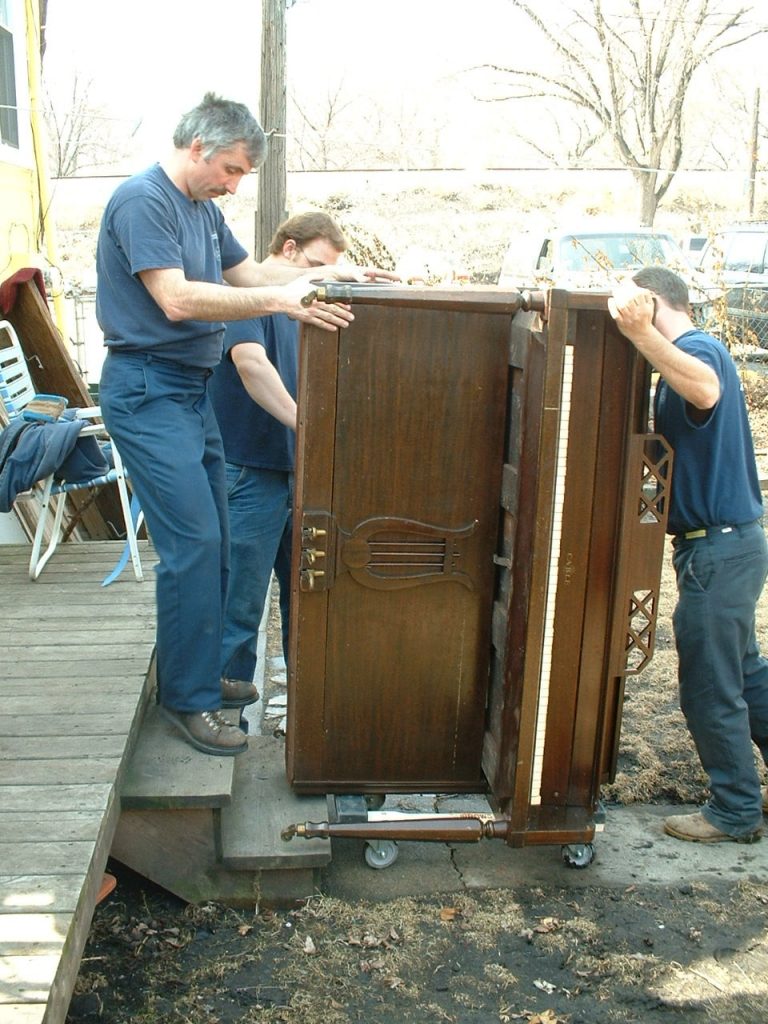
Again, use a pad or a piece of cardboard as a buffer between the piano and the landing’s edge. These cheating techniques are so much easier than having to get under the piano and actually carry it over these few steps.
Once all the steps have been traversed using the cheat and the piano is safely standing on top of the deck, then again, it must be mounted onto the dolly. This upright piano dolly mount and every dolly mount will depend upon the consideration of the number of consecutive stairs to be further encountered in the remaining move path. If there will be 1 step or less on the remaining move path, put the upright piano up onto the dolly on
If there are too many consecutive steps at any given point in the
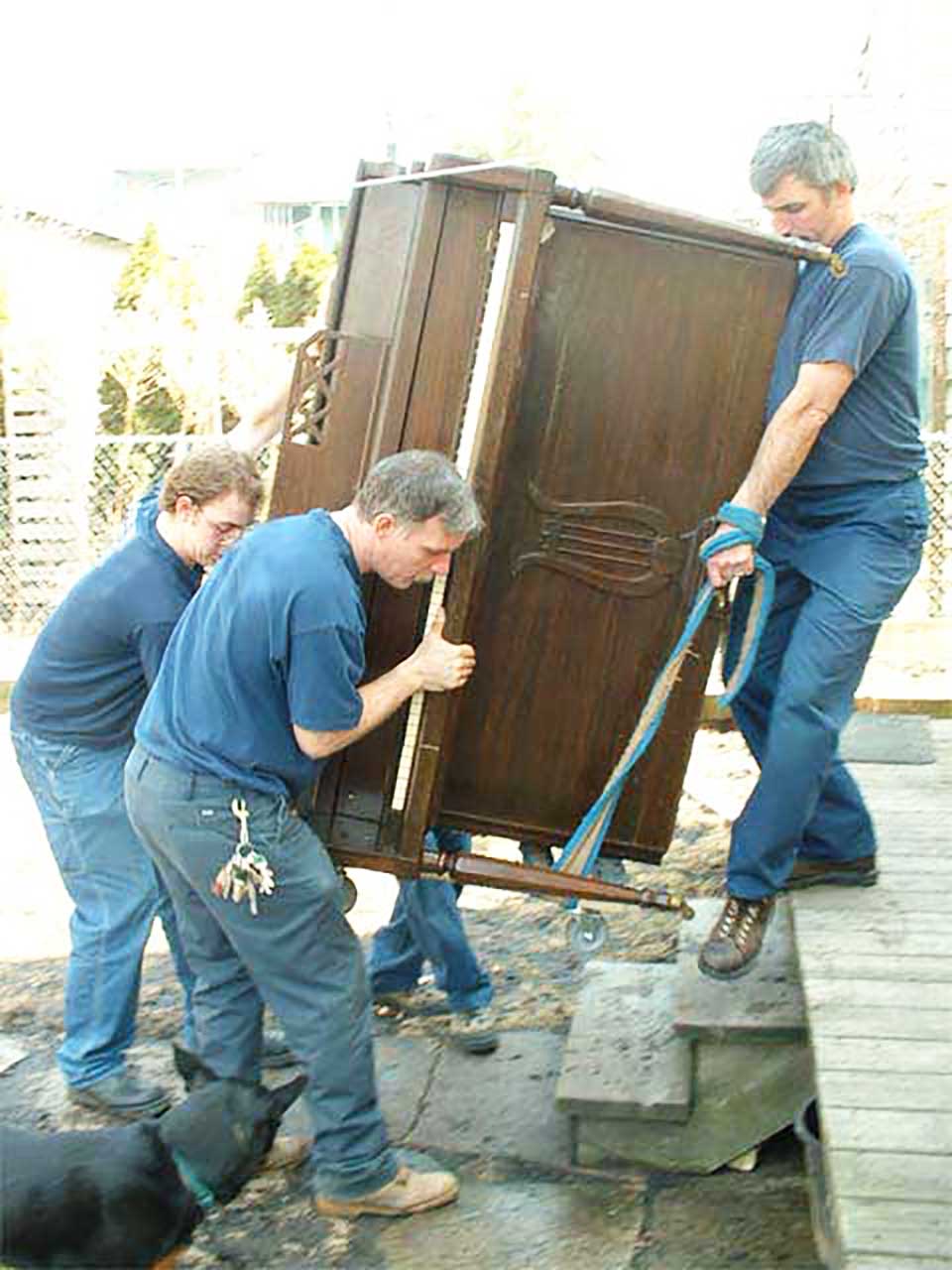
Notice in the action picture below that the first step has been cheated with the dolly and just 3 more steps are well covered by the piano’s bottom. The 4th step that it could reach when tipped down would not be covered enough for a safe cheat. This is because the edge of the piano is not covering enough of the landing and it might slip off of the step. Besides, in this case, there is even one more step than that so this crew would absolutely have to carry this piano in order to traverse all the steps.

Carrying the piano up/
How to Load a Piano
Dollying the piano
You place the upright piano with its keyboard side padded facing the wall of the truck so that if the piano gets accidentally scraped it only happens to the piano’s backside which does no damage to the piano’s finish. The upright’s front keyboard side is protected from scraping damage from the truck wall by its pad. The piano needs to be securely double- or triple-belted to the truck wall and then it is safe to be trucked.
Drive the truck to a position on the street or in a parking lot as close to the destination point as possible. Remember – always first use the truck for transport and then use the dolly and cheats, only carrying the piano when necessary for what’s left of the
How to Conserve Human Energy During a Piano Move
In the pictures below (viewed from below and above the piano), the ramp would not reach all the way up to the top of the porch so the mover’s had to place it one step down and then use a little cheat to get the piano over the top step on the dolly. This is an excellent example of conserving human energy because lesser trained piano movers would have given up on the ramp and carried this piano up all of the stairs to the porch. These guys did it all on the dolly using the ramp and a little cheat.


As they are doing here, you always want to try to use as little human strength during a piano move as possible .
The secret to do-it-yourself piano moving (or any kind of DIY moving for that matter) is to have plenty of people on each segment of the move so that you don’t get overloaded or rushed to get the job done. You also need to have the right equipment and the right techniques to do the job as easily as possible.
Everyone should use the piano moving equipment and good piano moving techniques and should be constantly thinking of easier ways to accomplish each task with the minimum amount of human exertion. Always try to only make exertions when absolutely necessary because, besides exhausting people of their strength, any exertion, especially strong exertions, can lead to an unwanted injury like a hernia, a back problem, a shoulder socket problem or damage to the piano!
Once you arrive at the destination and are safely parked, the piano is unbelted from the truck wall and remounted on the dolly, again on its feet or on its side depending on the aforementioned 4 consecutive low steps rule.
Next, the piano is dollied and cheated
Moving an upright piano is not something you should do on your own unless you are 100% prepared for the piano moving challenges ahead of you. If you’re unsure what to do even after reading the
Please browse through our piano moving posts for more detailed information before planning a move.


